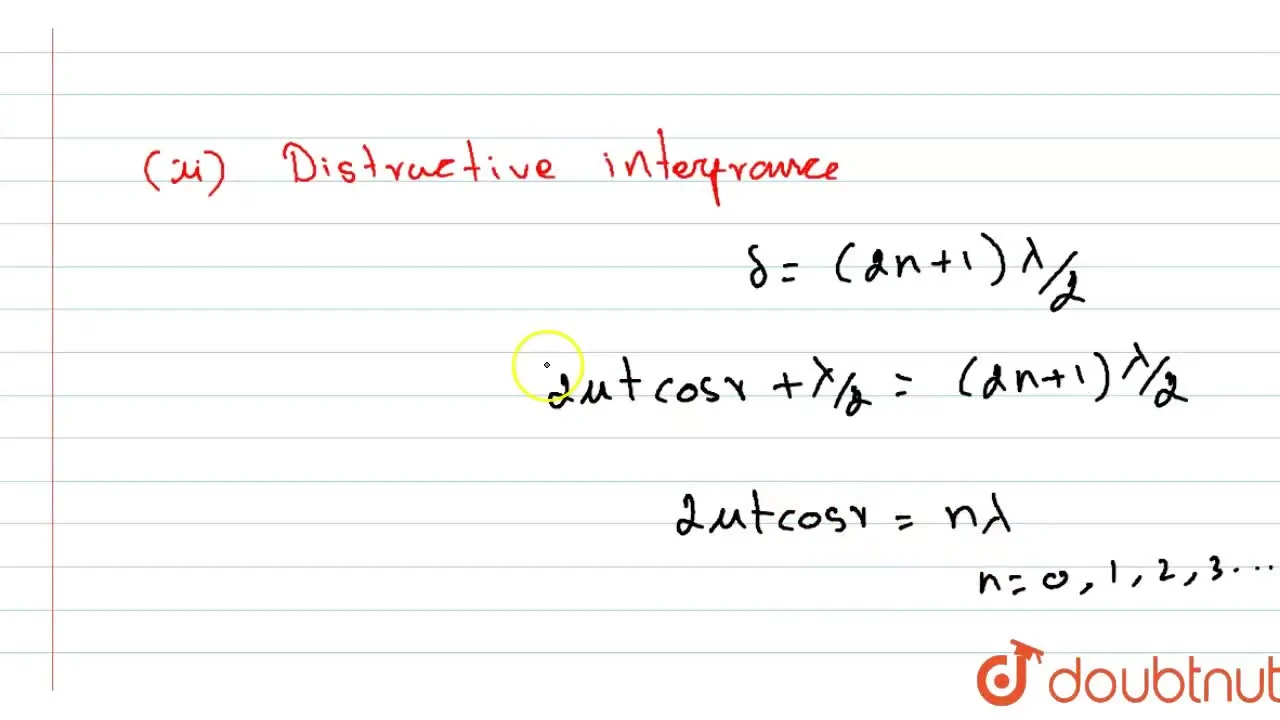Obtain the equaitons for constructive and destructive interference for transmitted and reflected waves in thin films.
Interference in thin films: Solution in Tamil
Video Solution
Text Solution
(i) Consider a thin film of transparent material of refractive index μ (not to confuse with order of fringe n) and thickness d. A parallel beam of light is incident on the film at an angle i. (ii) The wave is divided into two parts at the dark fringes upper surface, one is reflected and the other is refracted. (iii) The refracted part, which enters into the film, again gets divided at the lower surface into two parts, one is transmitted out of the film and the other is reflected back in to the film.
For transmitted light: (i) The light transmitted may interfere to produce a resultant intensity. Consider the path difference between the two light waves transmitted from B and D. (ii) The two waves moved together and remained in phase up to B where splitting occurred. The extra path travelled by the wave transmitted from D is the path inside Interference fringe pattern the film, BC + CD. (iii) If we approximate the incidence to be nearly normal (i = 0), then the points B and D are very close to each other. (iv) The extra distance travelled by the wave is approximately twice thickness of the film, BC + CD = 2d. As this extra path is traversed in a medium of refractive index μ , the optical path difference is, δ=2μd (v) The condition for constructive interference in transmitted ray is,
2μd=nλ
(vi). Similarly, the condition for destructive interference in transmitted ray is,
2μ=(2n−1)λ2
For reflected light:
(i) It is experimentally and theoretically proved that a wave while travelling in a rarer medium and getting reflected by a denser medium, undergoes a phase change of π . (ii) Hence, an additional path difference of λ2 should be considered. Consider the path difference between the light waves reflected by the upper surface at A and the other wave coming out at C after passing through the film. (iii) The additional path travelled by wave coming out from C is the path inside the film, AB + BC. For nearly normal incidence this distance could be approximated as, AB + BC = 2d. (iv) As this extra path is travelled in the medium of refractive index μ , the optical path difference is, δ=2μd . (v) The condition for constructive interference for reflected ray is,
2μd+λ2=nλ or 2μd=(2n−1)λ2
(vi) The additional path difference λ2 is due to the phase change of it in rarer to denser reflection taking place at A. (vii) The condition for destructive interference for reflected ray is,
2μd+λ2=(2n+1)λ2 or 2μd=nλ .
|
Updated on:21/07/2023
Similar Questions
Thin film Interference
37:20View SolutionIn one case, the film shows the interference of the thin film. Film thickness medium mu_2 Is equal to wavelength in
View SolutionExplain interference due to thin films.
03:20View SolutionFor observing interference in thin films with a light of wave length lambda the thickness of the film :
02:05View SolutionThin film interference
35:55View SolutionInterference By a thin film
41:31View SolutionThin Film Interference||FraunhOFer Diffraction
01:03:07View SolutionThin Film Interference & Wedge Film Interference
42:36View Solution


